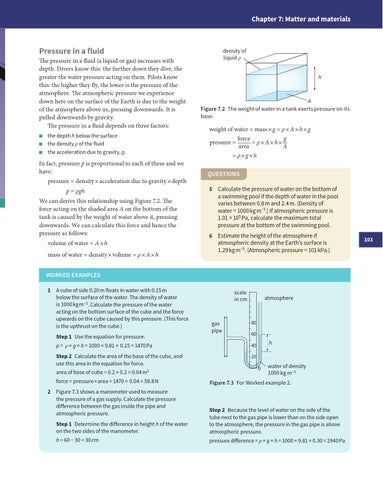Chapter 7: Matter and materials
Pressure in a fluid
The pressure in a fluid (a liquid or gas) increases with depth. Divers know this: the further down they dive, the greater the water pressure acting on them. Pilots know this: the higher they fly, the lower is the pressure of the atmosphere. The atmospheric pressure we experience down here on the surface of the Earth is due to the weight of the atmosphere above us, pressing downwards. It is pulled downwards by gravity. The pressure in a fluid depends on three factors: ■ ■ ■
the depth h below the surface the density ρ of the fluid the acceleration due to gravity, g.
In fact, pressure p is proportional to each of these and we have: pressure = density × acceleration due to gravity × depth p = ρgh We can derive this relationship using Figure 7.2. The force acting on the shaded area A on the bottom of the tank is caused by the weight of water above it, pressing downwards. We can calculate this force and hence the pressure as follows: volume of water = A × h mass of water = density × volume = ρ × A × h
density of liquid ρ h
A Figure 7.2 The weight of water in a tank exerts pressure on its base.
weight of water = mass × g = ρ × A × h × g force g = ρ×A×h× pressure = area A = ρ×g×h QUESTIONS 5
Calculate the pressure of water on the bottom of a swimming pool if the depth of water in the pool varies between 0.8 m and 2.4 m. (Density of water = 1000 kg m−3.) If atmospheric pressure is 1.01 × 105 Pa, calculate the maximum total pressure at the bottom of the swimming pool.
6
Estimate the height of the atmosphere if atmospheric density at the Earth’s surface is 1.29 kg m−3. (Atmospheric pressure = 101 kPa.)
WORKED EXAMPLES 1
A cube of side 0.20 m floats in water with 0.15 m below the surface of the water. The density of water is 1000 kg m−3. Calculate the pressure of the water acting on the bottom surface of the cube and the force upwards on the cube caused by this pressure. (This force is the upthrust on the cube.) Step 1 Use the equation for pressure:
gas pipe
atmosphere
80 60
p = ρ × g × h = 1000 × 9.81 × 0.15 = 1470 Pa
40
Step 2 Calculate the area of the base of the cube, and use this area in the equation for force.
20
area of base of cube = 0.2 × 0.2 = 0.04 m2 force = pressure × area = 1470 × 0.04 = 58.8 N 2
scale in cm
Figure 7.3 shows a manometer used to measure the pressure of a gas supply. Calculate the pressure difference between the gas inside the pipe and atmospheric pressure.
h
0
water of density 1000 kg m–3
Figure 7.3 For Worked example 2.
Step 1 Determine the difference in height h of the water on the two sides of the manometer.
Step 2 Because the level of water on the side of the tube next to the gas pipe is lower than on the side open to the atmosphere, the pressure in the gas pipe is above atmospheric pressure.
h = 60 − 30 = 30 cm
pressure difference = ρ × g × h = 1000 × 9.81 × 0.30 = 2940 Pa
103
